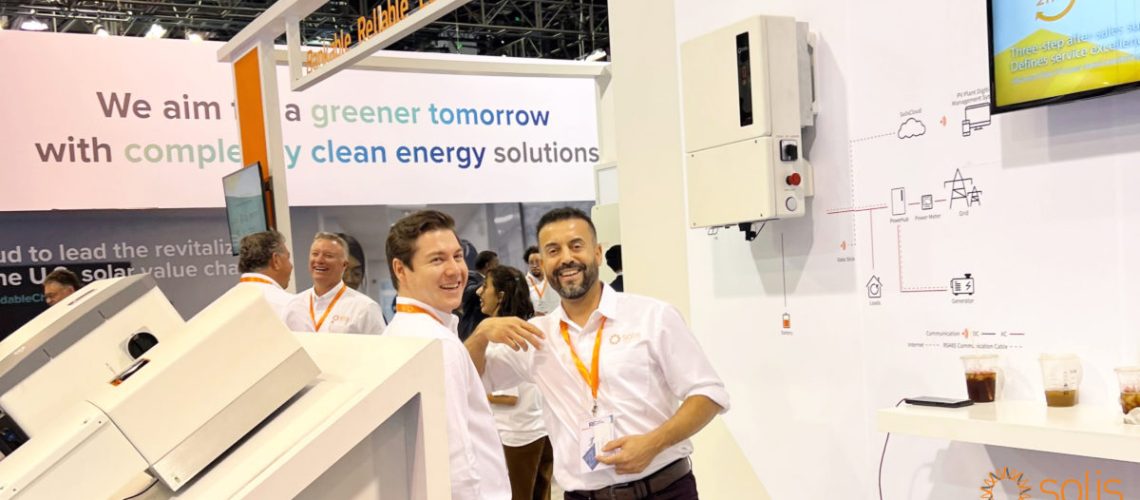Solis now offers a “whole home solution power hub” to provide power to every device in the home in the event of an outage.
pv magazine caught up with the U.S. team of the inverter manufacturer Ginlong Technologies (doing business in the U.S. under the “Solis” brand) at the Solis booth at last week’s RE+ trade show in Anaheim, California. According to Terence Parker, Senior Application Engineer at Solis U.S., the ample provision of backup power is becoming an important requirement for many households in the U.S. Solis now offers a “whole home solution power hub” to provide power to every device in the home in the event of an outage.
Parker is a veteran of the U.S. solar energy market and the Chinese manufacturer provides a wide range of solutions to not only the residential market, but also to the C&I and utility-scale segments. In the residential market, the severe multi-day outage in Texas in February 2021 brought home the need to be more prepared in severe weather events. PV is ideally suited to provide rooftop generation to households, but in cases of grid outages, conventional grid-tied PV systems are not sufficient to provide power to these homes. What is needed is adequate battery storage and an inverter that can island the home from the electricity grid.
But Solis is going even further than that. Parker describes the conventional backup solution that provides power to a critical load panel, with only loads connected to this panel receiving backup power in an outage. At RE+ Solis presented their “whole home solution power hub” that aggregates Solis inverters to supply not only critical home loads with electricity. Adequate battery storage is obviously required as well and here too modular components can be stacked together to provide the punch in case the grid drops away.
The whole home solution power hub cannot only integrate PV generation, but also other sources of power, including conventional backup generators that fire up when all else fails. In the typical whole home backup system, the conventional generator is connected to the Solis Powerhub, which in turn is connected to the Solis Residential Hybrid Storage Inverter. The power range for this solution goes from 3.8 kW to 11.4 kW. Six inverter models cover this range and all six are referred to as S6-EH1P(3.8-11.4)K-H-US in the Solis product catalog. Each inverter is stackable up to ten inverters in parallel, providing ample power in case of need. Up to 80 kWh of storage capacity can be provided per inverter and the Solis S6 inverter is UL 9540 certified to work with multiple battery brands.
Efficient performance is ensured by a maximum PV input current up to 16A per string along with a high DC to AC ratio of 1.6 for more PV power capacity. A single S6 can generate up to 50A/11.4 kW of continuous backup power and the transfer time is below 10ms for all backed up loads. Finally, DC to DC battery charging provides for optimal utilization of PV generated electricity.
At RE+ Solis also showcased its C&I and utility-scale solutions and here too, Solis provides a wide range of output from 25 kW to 100 kW and for the largest projects 125 kW to 255 kW. Parker pointed to an expansion of this range to 350 kW in the near future as PV power plants in the U.S. continue to gain in size. Parker also points to the unique 75 to 100 kW product that occupies a niche that other inverter manufacturers have not addressed. The S5-GC(75-100)K-US inverter series boasts up to 10 MPPTs with a maximum efficiency of 98.8% (CEC efficiency 98.3%). The MPPT voltage range stands at 180-1000V.
Just as backup power has become an important application in the U.S. and other countries, repowering has emerged as an attractive opportunity in mature PV markets like North America. Inverters need to be swapped out to boost the performance of older plants and Solis’ wide range of highly efficient inverters provides the right recipe to retrofit these older systems with a wide range of operating voltages and input currents. Finally, Solis has developed AI technology to further boost the performance in repowering scenarios.



